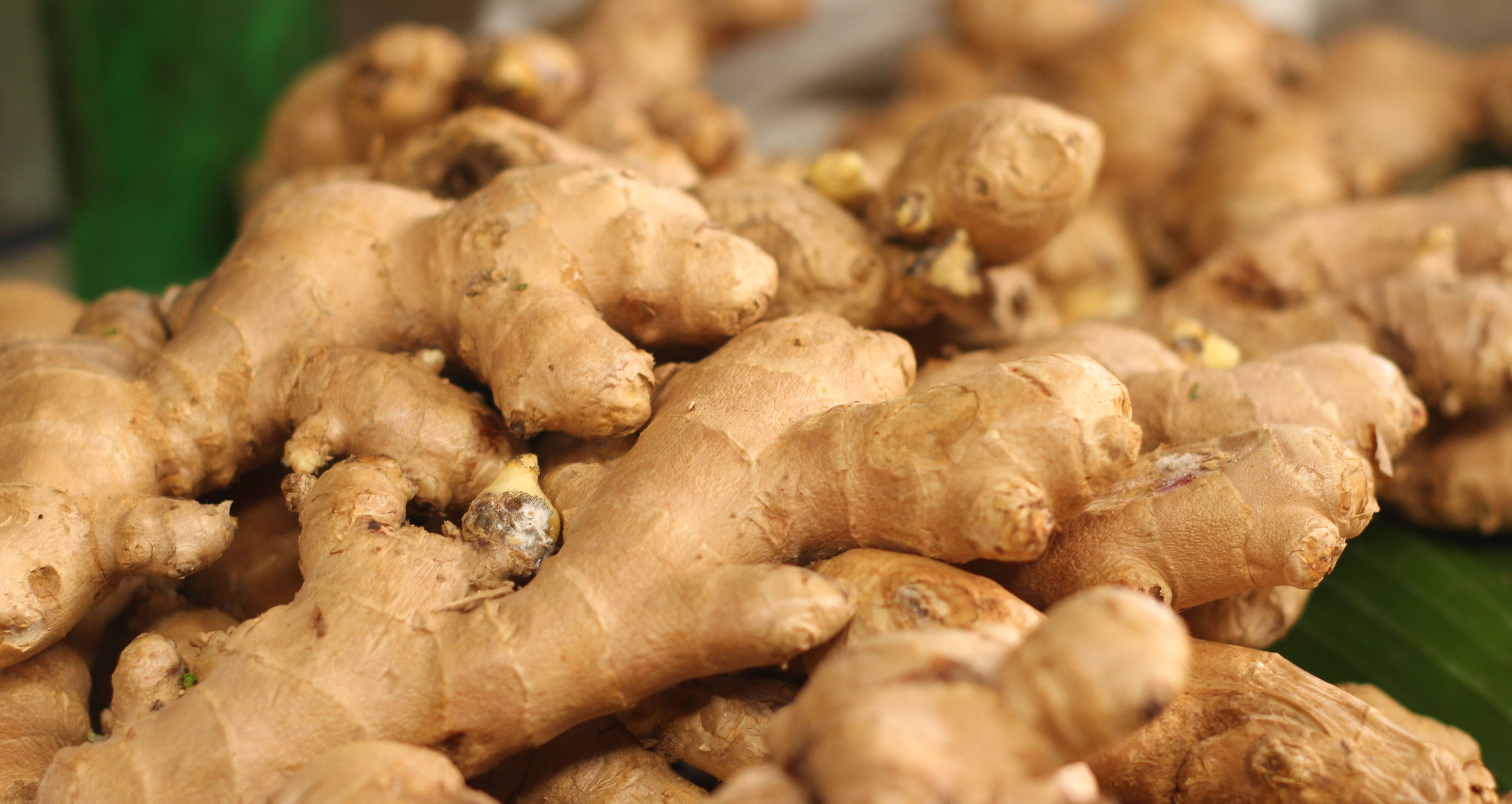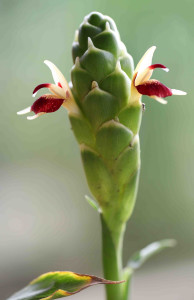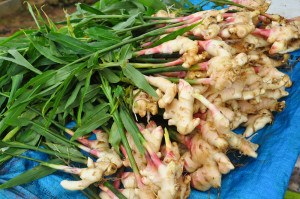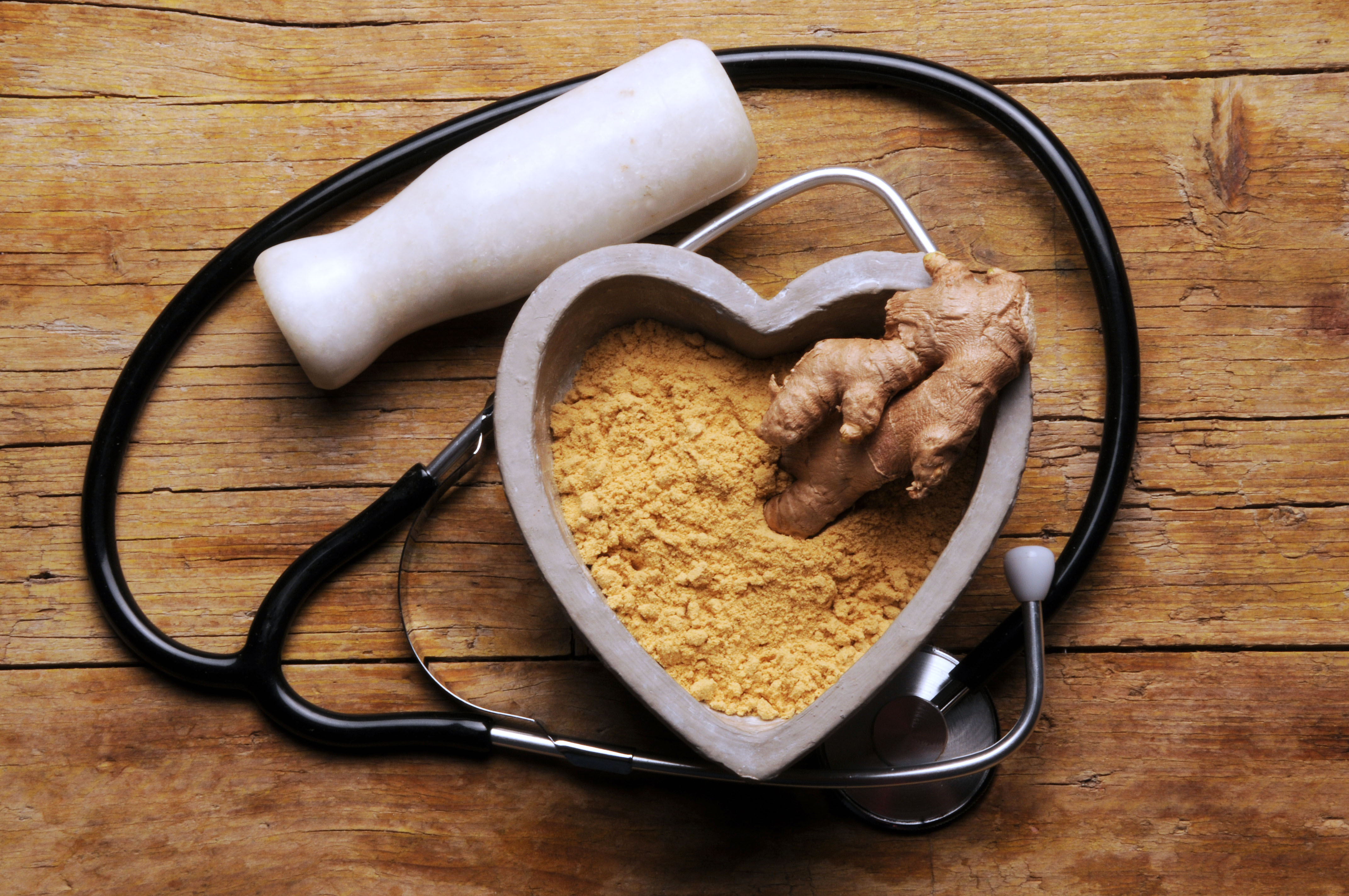
If your mom ever gave you ginger ale for an upset stomach, she was on to something! Ginger is an age-old remedy for nausea, indigestion, menstrual cramps and arthritic pain. It has been used for over 2,000 years by a wide range of cultures in healing numerous conditions.
In Ayurvedic medicine from ancient India, ginger is given the name vishwabbesaj which means “the universal medicine.”

The beautiful ginger flower
Whenever a food has been used for this long as a medicine, I get curious and take a dive into the research: Does modern science validate this ancient wisdom? The answer is YES!
Studies show that ginger is effective for:
- Reducing nausea from motion, morning sickness in pregnancy, after surgery or chemotherapy
- Easing chronic indigestion and gas
- Lowering LDL cholesterol
- Fighting infections, especially colds and flu
- Reducing inflammation and pain associated with arthritis
- Relieving menstrual camps
- Improving blood sugar control
- Protecting against age-related decline in brain function
- Treating gum diseases including gingivitus
Ginger as Medicine
NOTE: Try to buy organically grown ginger. Much of the commercially grown ginger in the market comes from China. During cultivation, storage and processing ginger can be barraged with chemicals, including mercury compounds, chlorinated hydrocarbons, fungicides and fumigants.
To relieve nausea and gas – Powdered is considered the most effective form for severe nausea but fresh is also effective in cases of mild distress or to ease digestion after a meal
Powdered ginger 1 or 2 grams in capsule form or 1/2 – 1 tsp. powdered ginger mixed in a little water
Ginger extract or tincture Take about 2 droppersful (2 ml) of a 1:2 tincture Here’s a good product: http://www.gaiaherbs.com/products/detail/218/Ginger-Root-Certified-Organic
Ginger tea Slice a 1-inch piece of ginger root into thin coins (you don’t have to peel it), add to 2 cups of water and bring to a boil. Simmer for 5 – 10 minutes. It will keep in the refrigerator for about 1 week. Or put 1/4 – 1/2 tsp of powdered ginger in an 8 oz. mug and pour boiling water over it. For extra flavor try a squeeze of lemon or pinch of ground nutmeg.
Crystallized ginger Not my favorite form because of the added sugar but 1 or 2 pieces after a meal makes a nice dessert in addition to helping with digestion
For inflammatory conditions – Fresh has been shown to be most effective, especially for Rheumatoid arthritis.
Fresh ginger 20g in divided doses per day of fresh ginger root (about a 1/2 inch piece)
Dry powdered ginger 2-4g in divided doses per day
For Blood sugar control and lowering LDL cholesterol
Dry powdered ginger 2-4g in divided doses per day
For general health
As a supplement up to 4 grams per day is considered safe. Try to incorporate it as a food into your diet as much as possible!
Note: It is important to take caution when it is used therapeutically if it is in combination with blood thinning medications or medications for decreasing blood sugar. Ginger has been shown to be effective for both of the conditions which these medications treat and large amounts as a supplement could enhance their effect. Check with your doctor. Curbing use at least two weeks before having surgery is also advised.
Ginger as a Culinary Wonder

Fresh ginger root with leaves
There are few foods and dishes that do not marry well with ginger. Even Italian cuisine! At least one chef thinks it adds another dimension to his spaghetti sauce: http://www.bonappetit.com/columns/back-of-the-napkin-columns/article/matt-leblanc
Here are some ways to use this “universal medicine”:
Ginger tea (see above for instructions)
Make a healthy ginger ale by adding a natural sweetener and sparkling water to a strong brew of ginger tea
Add ginger to your smoothies Use a chopped piece of fresh ginger root, brewed ginger tea or powdered ginger
Grated frozen ginger A microplane works well for this and it can be added to soups, sautes, or cooked vegetables.
Crystallized ginger This usually has too much sugar for me to recommend but you can find the non-sugar coated type at Trader Joe’s. Or rinse the extra sugar off – it will still be plenty sweet. One piece is enough to satisfy the urge for a sweet after a meal and aid digestion.
Pickled Sushi Ginger Not just for sushi! Again it has some sugar, but you would not be using much of it. Use in salads and with fish.
Ginger goes well with seafood, meat, poultry, vegetables, tofu or tempeh, fruits and desserts. Use it in marinades, sauces, dressing, soups, and spreads.
Ginger Vinaigrette
This is delicious with shredded carrots, beets, Napa cabbage or a kale salad. Also great with cubed roasted sweet potatoes or winter squash.
Note: You can add 2 Tbs tahini (sesame paste) or other nut butter for a different flavor profile and to add protein.
¼ cup shallot or sweet onion, finely chopped
1 – 2 inch piece peeled fresh ginger, finely chopped or grated
1 clove garlic, finely chopped
¼ cup rice vinegar
1 Tbs. soy sauce or Shoyu
1 tsp. toasted sesame oil
½ cup olive oil
In a blender or food processor puree the shallot, ginger, and garlic with the rice vinegar, soy sauce or Shoyu, and sesame oil. With the motor still running, add the olive oil slowly and blend until smooth. Add in the optional tahini or nut butter and blend again until smooth. Will keep refrigerated for a week or so.
Ginger kitchen tips and tricks
- Use the edge of a spoon to peel fresh ginger rather than a knife. It’s easier and faster and you’ll waste less.
- Wrap and freeze peeled ginger to have it handy, Grate with a microplane when ready to use.
References
Alizadeh-Navaei, R., Roozbeh, F., Saravi, M., Pouramir, M., Jalali, F., & Moghadamnia, A. A. (2008). Investigation of the effect of ginger on the lipid levels. A double blind controlled clinical trial. Saudi Medical Journal, 29(9), 1280–1284.
Altman, R. D., & Marcussen, K. C. (2001). Effects of a ginger extract on knee pain in patients with osteoarthritis. Arthritis and Rheumatism, 44(11), 2531–2538.
Ernst, E., & Pittler, M. H. (2000). Efficacy of ginger for nausea and vomiting: a systematic review of randomized clinical trials. British Journal of Anaesthesia, 84(3), 367–371.
Jungbauer, A., & Medjakovic, S. (2012). Anti-inflammatory properties of culinary herbs and spices that ameliorate the effects of metabolic syndrome. Maturitas, 71(3), 227–239. http://doi.org /10.1016/j.maturitas.2011.12.009
Karuppiah, P., & Rajaram, S. (2012). Antibacterial effect of Allium sativum cloves and Zingiber officinale rhizomes against multiple-drug resistant clinical pathogens. Asian Pacific Journal of Tropical Biomedicine, 2(8), 597–601. http://doi.org/10.1016/S2221-1691(12)60104-X
Khandouzi, N., Shidfar, F., Rajab, A., Rahideh, T., Hosseini, P., & Mir Taheri, M. (2015). The Effects of Ginger on Fasting Blood Sugar, Hemoglobin A1c, Apolipoprotein B, Apolipoprotein A-I and Malondialdehyde in Type 2 Diabetic Patients. Iranian Journal of Pharmaceutical Research : IJPR, 14(1), 131–140.
Mindell, E. (2000). Earl Mindell’s new herb bible (Completely rev. and updated ed.). New York: Simon & Schuster.
Murray, M. T., Pizzorno, J. E., & Pizzorno, L. (2005). The encyclopedia of healing foods. New York: Atria Books.
Wang, S., Zhang, C., Yang, G., & Yang, Y. (2014). Biological properties of 6-gingerol: a brief review. Natural Product Communications, 9(7), 1027–1030.

